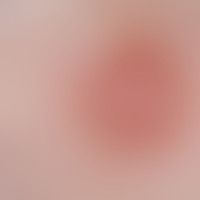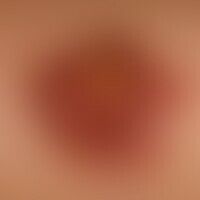Image diagnoses for "Nodule (<1cm)"
268 results with 997 images
Results forNodule (<1cm)

Basal cell carcinoma nodular C44.L
basal cell carcinoma nodular: detail enlargement. nodule with smooth shiny surface. bizarre vascular architecture.

Neurofibromatosis (overview) Q85.0
Central-peripheral neurofibromatosis (palmo-plantar neurofibromatosis or type III neurofibromatosis) Chronic inpatient palmo-plantar neurofibromatosis, progressive in childhood; now no longer progressive, soft, skin-colored, painless palmo-plantar nodules and plaques.

Melanoma acrolentiginous C43.7 / C43.7
Melanoma, malignant, acrolentiginous. Here: amelanotic malignant melanoma: Chronic inpatient tumor in an 80-year-old patient, existing since 2 years, localized at a pressure-exposed site, flat, sharply defined, slightly painful, similar to an ulcer, slightly raised, flat, ulcerated. The diagnosis as primary tumor was made by finding a metastasis. Note: The diagnosis of malignant melanoma in the presented case can only be made histologically. Clinically, at best, a suspected malignant tumor can be made, which must be clarified histologically.

Nevus sebaceus Q82.5
Sebaceous nevus: Formation of a pigmented hidradenoma within the clearly defined, hairless sebaceous nevus.

Merkel cell carcinoma C44.L
Merkel cell carcinoma: rapidly growing non-symptomatic nodule, in a 73-year-old female patient

Plantar fibromatosis M72.2
Plantar fibromatosis: Chronic stationary, subcutaneously located, skin-coloured to brown, approx. 5 x 4 cm large, coarse knot of a 60-year-old man, localised at the Arcus plantaris. 10 years of pressure pain and difficulties in rolling.

Komedo L73.8
Comedo (giant comedo): approx. 2.0 cm large, firm knot with a black, keratotic centre about 0.3 cm in size.

Infant haemangioma (overview) D18.01

Cornu cutaneum L85
Cornu cutaneum: Cornu cutaneum that has been in existence for many years, broadly seated, and has been in painful pressure for some time. close-up

Primary cutaneous cd30 positive large cell t cell lymphoma C86.6

Dermatofibrosarcoma protuberans (overview) C44.-
Dermatofibrosarcoma protuberans. solitary, chronically dynamic, continuously growing for 4-5 years, poorly delimitable to the side and depth, woody solid, smooth, bumpy, red node. the lateral depth extension clearly exceeds the protuberant part (iceberg phenomenon).

Blue nevus D22.-
Blue naevus. blue-black shimmering through, sharply defined, clearly and evenly indurated knots with a smooth shiny (like polished) surface.

Folliculitis profunda (overview) L01.0
Folliculitis profunda. acute, solitary, since 1 week existing, moderately sharply definable, firm, very pressure dolent, red, centrally ulcerated nodule (left mamma). distinct perilesional erythema.

Acuminate condyloma A63.0

Keloid (overview) L91.0
Keloids. since puberty known now healed acne vulgaris. for months development of these papular or nodular elevations of the skin.

Angiokeratoma circumscriptum D23.L
Angiokeratoma circumscriptum. 20-year-old female patient with a lesion composed of several types of efflorescence. The skin lesions present have existed since birth. The blue-black parts have gradually developed over the past five years. In addition to two-dimensional red spots (upper part), red papules (lower part) and blue-black bumped plaques with a smooth, shiny surface are found. Soft, spongy consistency in the centre.

Squamous cell carcinoma of the skin C44.-
Squamous cell carcinoma of the skin: 1.5 cm large, spherical, red node (tumor) with ulcerated surface and hemorrhagic crust on the forehead of a 67-year-old female patient.

Pilomatrixoma D23.L
Pilomatrixoma, reddish-bluish, in a marginal area whitish, 5 mm large tumor on the hairy head.

Keratoakanthoma classic type D23.L
Keratoakanthoma classic type: rarelocalization of a keratoakanthoma otherwise typical of the course (existing for 6 weeks) and clinical aspect





